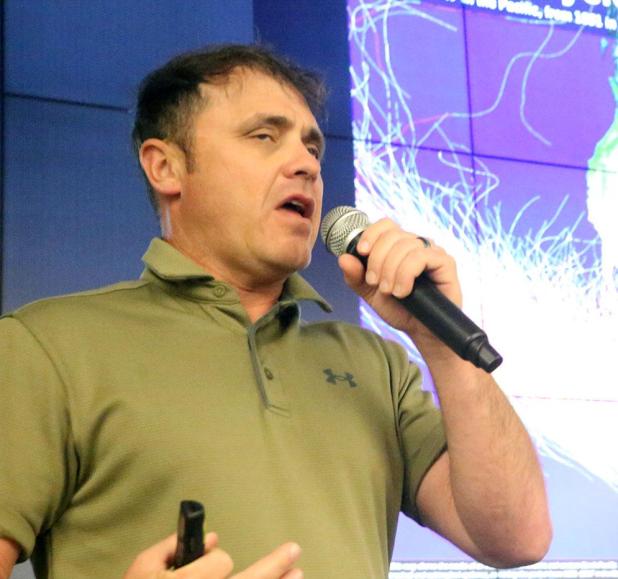
Doug Cramer of the National Weather Service in Lake Charles talks Wednesday about predictions for the 2024 hurricane season.
The Review/Bill Decker
UPDATED WITH STORY: Road work could snarl hurricane evacuation
Officials from across the region heard Wednesday about a dual threat: predictions for an active hurricane season and road work that could turn evacuation into what one deputy called a “nightmare.”
Representatives at all levels of government gathered Wednesday for the Port of Morgan City’s annual hurricane preparedness meeting at the Emergency Operations Center. Much of the talk turned to cones and phones.
The cones are the familiar hurricane track forecasts, and many are expected to result from what forecasters say will be an active tropical weather season. And there are orange cones marking highway projects that create potential choke points on U.S. 90, the key evacuation route.
Law enforcement agencies are also hoping they have a work-around for the cell service outage that hampered emergency communications for days after Hurricane Ida in 2021.
Doug Cramer of the National Weather Service in Lake Charles pointed to the Colorado State Tropical Weather and Climate Center forecast, which predicts 23 named storms during the hurricane season that begins June 1.
Eleven of these storms are expected to become hurricanes, with sustained winds of at least 74 mph. Five are expected to become major hurricanes with winds of at least 111 mph.
Those numbers are roughly half again the average since 1990, and they agree generally with an earlier forecast from AccuWeather.
The culprits, Cramer said, are above-average temperatures in the Gulf of Mexico and Atlantic Ocean and the end of a strong El Niño weather pattern, probably shifting to La Niña by the end of the year.
El Niño patterns generally inhibit hurricane development in the Gulf, while La Niña conditions are favorable for that development.
Hanging over the predictions is a worrisome trend toward rapid intensification of storms.
Cramer cited Hurricane Otis, which hit Acapulco on Mexico’s southwest coast in October. Otis became a tropical storm, with winds exceeding 39 mph, and exploded into a Category 5 hurricane with winds of 160 mph, all within 24 hours.
Otis is blamed for at least 52 deaths and $15 billion in damage.
“We’re starting to see an increased frequency in that phenomenon …,” Cramer said.
“We may think something is coming to Morgan City. We may think we know how strong it is. But it is really hard to forecast rapid intensification.”
If an approaching hurricane leads to an evacuation order, the challenge will be even greater this year.
U.S. 90, along with La. 182 and La. 70, are evacuation routes. But highway projects on U.S. 90 currently have westbound traffic narrowed to one lane for six miles between Franklin and Sorrel and to one lane in both directions on a three-mile stretch through New Iberia.
If an evacuation is necessary, said St. Mary Sheriff’s Office Chief Deputy John Kahl, “I can summarize it by saying it’s going to be a nightmare.”
Along with the potential for congestion where two lanes merge, Kahl said, some of the exits in those areas are also closed for road work. Drivers whose vehicles run out of gas, overheat or break down will have trouble getting out of the single lane of traffic.
“The thing we’re trying to emphasize as much as possible,” Kahl said, “is if there is any anticipation that there’s going to be an evacuation, do it early.”
Emergency communication became a huge problem during Hurricane Ida.
Some local agencies, among them the Morgan City Police Department, used a system called FirstNet. The digital system relies on cellphone towers.
But when Ida hit, a key ATT facility in the storm’s path was damaged, knocking out cellphone service, and with it police radios, for a few days.
“It was horrible,” Morgan City Mayor Lee Dragna said. “It was really bad.”
The outage sent the police scrambling to find analog radios.
Kahl said the Sheriff’s Office was forced to send people out with messages for deputies in east St. Mary.
Now, Kahl and Morgan City Police Chief Chad M. Adams said, both agencies have the capability to communicate if cell service goes out.
A perceived lack of portable cellphone tower availability on the part of service providers has also been a sore spot.
Tim Osborn of the National Oceanic and Atmospheric Administration said he recently saw a portable tower while attending the French Quarter Festival in New Orleans.
“Why can’t we have those in Morgan City, Houma, Lockport or Raceland?” Osborn said.
Some officials were able to report progress on hurricane preparation.
Kahl said the Sheriff’s Office has acquired heavy vehicles that are better able to provide rescue work.
Mike Brocato, operations manager of the St. Mary Levee District, reported on projects designed to deal with storm surge flooding.
Three-quarters of hurricane deaths are related to water, Cramer said Wednesday, and half of those are related to storm surge.
The Bayou Teche Flood Control Structure is in operation to protect eastern St. Mary from storm surge coming up the Charenton Canal, Brocato said. The Bayou Chene Flood Control Structure, which was created to stop back-flooding from the west, can also be closed to prevent flooding resulting from storm surge to the east, Brocato said.
The district has also built a removable flood wall in the area near Metal Shark and Gulf Craft near Franklin.
Lt. Janelle Piche said the Coast Guard will patrol local waterways and enforce vessel restrictions as tropical weather approaches.
